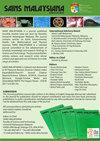In Vitro and in Vivo Assays of Selected Plant Extracts Against Fruit Rot Fungi
IF 0.8
4区 综合性期刊
Q3 MULTIDISCIPLINARY SCIENCES
引用次数: 0
Abstract
Post-harvest losses of crops in Malaysia is estimated at around 20%. Fungal infection is one of the primary causes of post-harvest loss in fruits. The common use of synthetic fungicide to combat fruit rot fungi poses negative impacts on human health and the environment. The objective of this study was to determine the efficacy of selected plant species as a safer alternative for post-harvest treatment. Ethanolic leaf extracts of Piper sarmentosum, Psidium guajava, and Cymbopogon citratus were tested against Fusarium oxysporum from tomato rot, Fusarium proliferatum from banana rot, and Colletotrichum gloeosporioides from mango rot. In vitro analysis was conducted using poisoned food bioassay and the percentage inhibitions of Fusarium oxysporum growth were 93.50% by Piper sarmentosumextract, 46.68% by Psidium guajavaextract, and 40.48% by Cymbopogon citratus extract. A test on a different fungus, Fusarium proliferatum, showed that Piper sarmentosum, Psidium guajava, and Cymbopogon citratusextracts displayed percentage inhibitions of 88.78%, 36.66%, and 22.44%, respectively. In vitro test on Colletotrichum gloeosporioides showed that Piper sarmentosum extract inhibited the fungal growth by 96.23%, while Cymbopogon citratus and Psidium guajava extract inhibited the fungal growth by 52.62% and 52.22%, respectively. The mechanism of action of these extracts appeared to be fungistatic. Piper sarmentosum was selected for further analysis by in vivo assay as it displayed the most significant anti-fungal action. The study was conducted using Piper sarmentosumleaf extract of various concentrations (25, 50, 50, and 100 mg/mL). The leaf extract displayed dose-dependent activity, with the highest reduction in disease severity observed at concentration of 100 mg/mL. The findings showed the potential use of Piper sarmentosum, Psidium guajava, and Cymbopogon citratus leaf extract as anti-fungal agent for post-harvest treatment to minimize fruit loss. Piper sarmentosum leaf extract showed comparable inhibitory action to commercial fungicide carbendazim.特定植物提取物对水果腐霉菌的体外和体内试验
马来西亚农作物收获后的损失估计约为 20%。真菌感染是水果收获后损失的主要原因之一。普遍使用合成杀真菌剂来对付水果腐烂病真菌会对人类健康和环境造成负面影响。本研究的目的是确定选定植物物种作为采后处理更安全替代品的功效。针对番茄腐烂病中的 Fusarium oxysporum、香蕉腐烂病中的 Fusarium proliferatum 和芒果腐烂病中的 Colletotrichum gloeosporioides,测试了 Piper sarmentosum、Psidium guajava 和 Cymbopogon citratus 的乙醇叶提取物。使用有毒食品生物测定法进行了体外分析,结果表明,胡椒提取物对恶孢镰刀菌生长的抑制率为 93.50%,瓜子黄酮提取物为 46.68%,柠檬香蒲提取物为 40.48%。对另一种真菌 Fusarium proliferatum 的测试表明,胡椒、番石榴和柠檬香蒲提取物的抑制率分别为 88.78%、36.66% 和 22.44%。对球孢子菌的体外测试表明,胡椒萃取物对真菌生长的抑制率为 96.23%,而柠檬香蒲和番石榴萃取物对真菌生长的抑制率分别为 52.62% 和 52.22%。这些提取物的作用机制似乎是杀真菌。由于 Piper sarmentosum 的抗真菌作用最为显著,因此被选作体内试验的进一步分析对象。研究使用了不同浓度(25、50、50 和 100 毫克/毫升)的瓜蒌叶提取物。叶提取物显示出剂量依赖性活性,浓度为 100 毫克/毫升时,病害严重程度的降低幅度最大。研究结果表明,胡椒、番石榴和柠檬叶提取物可用作采后抗真菌剂,以最大限度地减少果实损失。瓜蒌叶提取物的抑制作用与商用杀真菌剂多菌灵相当。
本文章由计算机程序翻译,如有差异,请以英文原文为准。
求助全文
约1分钟内获得全文
求助全文
来源期刊

Sains Malaysiana
MULTIDISCIPLINARY SCIENCES-
CiteScore
1.60
自引率
12.50%
发文量
196
审稿时长
3-6 weeks
期刊介绍:
Sains Malaysiana is a refereed journal committed to the advancement of scholarly knowledge and research findings of the several branches of science and technology. It contains articles on Earth Sciences, Health Sciences, Life Sciences, Mathematical Sciences and Physical Sciences. The journal publishes articles, reviews, and research notes whose content and approach are of interest to a wide range of scholars. Sains Malaysiana is published by the UKM Press an its autonomous Editorial Board are drawn from the Faculty of Science and Technology, Universiti Kebangsaan Malaysia. In addition, distinguished scholars from local and foreign universities are appointed to serve as advisory board members and referees.
 求助内容:
求助内容: 应助结果提醒方式:
应助结果提醒方式:


